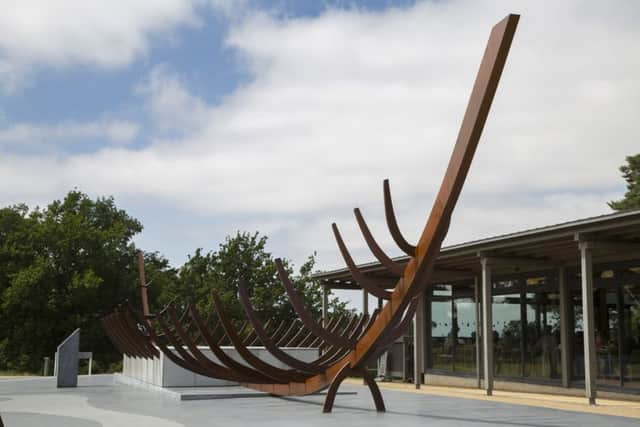History focus - Sutton Hoo ... Britain’s greatest Anglo-Saxon site reveals yet more!


Basil Brown and Edith Pretty revealed the richest grave in Europe to transform archaeologists’ understanding of Anglo-Saxon history, Andrew Southam reports
Some 83 years ago self-taught archaeologist Basil Brown uncovered the greatest ever Anglo-Saxon find.Wealthy widower Edith Pretty hired him in 1938 to excavate low grassy mounds on her Sutton Hoo estate, now Tranmer House, near Woodbridge in Suffolk.


Months before the darkness of the Second World War, Basil unearthed an iron ship’s rivet from the largest mound, then another and another, slowly revealing the structure of a 27 metre long Anglo-Saxon ship.
Advertisement
Hide AdAdvertisement
Hide AdLaying before him and his two helpers (the estate gardener and gamekeeper) in June 1939 was an undisturbed seventh century burial chamber.
Professional archaeologists alongside the Ipswich Museum, the British Museum, the Science Museum, Cambridge University and the government quickly moved in.


Two policemen had to guard the site.
Not only did Basil and Edith find the richest grave in Europe but their excavation transformed archaeologists’ understanding of the Anglo-Saxons.
The story of the discovery and Edith’s and Basil’s relationship is recounted in John Preston’s 2007 book The Dig, made into a hit film released last year starring Ralph Fiennes and Carey Mulligan.
Channel 4’s popular Time Team now plans to unlock new Sutton Hoo secrets.
Increased public interest in history inspired them to restart their programmes, last broadcast in 2014, through their official YouTube channel.
Alongside National Trust archaeologists and Historic England, the Time Team will use the latest scientific techniques without disturbing the Sutton Hoo cemetery ground.
Radar pictures pick up changes in the landscape before a magnetometer looks through the ground to find objects while 3D photographs recreate lifelike pictures of any findings.
Advertisement
Hide AdAdvertisement
Hide AdBack in August 1939 an inquest awarded all the finds to Edith, who gave them to the nation in the largest gift the British Museum has ever received.
Prime Minister Winston Churchill nominated her for a CBE, which she declined.
War broke out a few months later and the finds were stored underground at London’s disused Aldwych tube station.
Edith died in 1942 with the National Trust taking over the site in 1998.
Basil continued archaeological digs across Suffolk after the war before dying in 1977 aged 89.
An annual memorial lecture is given for this farmer’s son who taught himself Latin and French and earned diplomas through night school studies in geology, astronomy and geography.
Mystery remains over who was buried in the ship as acidic soil has completely decomposed their body.
Many experts choose King Raedwald, a powerful ruler from AD 599 to AD 624 in East Anglia, now modern-day Suffolk and Norfolk.
Advertisement
Hide AdAdvertisement
Hide AdRaedwald fits the bill as a person worthy of such a burial, coming from the right location at the right time, with artefacts linked to a Royal East Anglian dynasty.
Other possibilities include one of his sons, a king from a neighbouring East Saxon Kingdom or even a visitor of high status.
A strong clue points to Raedwald.
Britain in the seventh century was converting to Christianity and Raedwald was the first Christian king of the Angles.
But he hesitated over following Christian or pagan custom so built a temple to both.
Sutton Hoo’s burial chamber has Christian and pagan artefacts, hinting at Raedwald.
Will we ever know?
Whatever the answer, the find revolutionised knowledge about the Anglo-Saxon period.
The 263 recovered artefacts revealed a world of craftsmanship and cultural sophistication rather than what was previously considered to be the Dark Ages.
Pieces like the famous iron helmet, modelled on late Roman cavalry headwear, are artisanship hard to match today.


Advertisement
Hide AdAdvertisement
Hide AdCoins from the Merovingian dynasty, now modern France and Germany, and silverware from the Byzantine Empire, now modern Turkey, reveal extensive trading networks.
And the finds confirmed the Anglo-Saxon way of life portrayed in the epic medieval saga Beowulf.
This really was a time of warriors, great communal timber halls and impressive funerals, partly depicted in the animated fantasy 2007 film of the same name featuring actor Ray Winstone.
Sutton Hoo’s archaeology and engagement manager Laura Howarth explains its significance.
She said: “We often refer to the discovery of Sutton Hoo’s Great Ship Burial as being one that changed history.


“A bold statement to make and yet this discovery remains the richest burial ever found in medieval Europe.“Sutton Hoo has been referred to as England’s own Valley of the Kings.”
Digs continue making fresh discoveries including a second ship, Anglo-Saxon folk cemetery and even people’s bound bodies from possible seventh century executions.
But much more lies beneath.
Archaeologists have found tantalising traces of other cultures stretching across the Neolithic, Bronze and Iron Ages besides Roman, Anglo-Saxon and later periods.
Advertisement
Hide AdAdvertisement
Hide AdLaura hopes the new surveys “will tell us more about arguably lesser-known periods of Sutton Hoo’s history and bring different people’s stories to the fore as more pieces of the jigsaw puzzle as to how this landscape has been used over the centuries are hopefully revealed.”
All the finds are displayed in the British Museum and at Sutton Hoo.
The National Trust has published online the work of amateur photographers Barbara Wagstaff and Mercie Lack, who charted the dig in August 1939, at https://www.nationaltrustcollections.org.uk/article/the-photographic-collection-of-mercie-lack-and-barbara-wagstaff-at-sutton-hoo site.